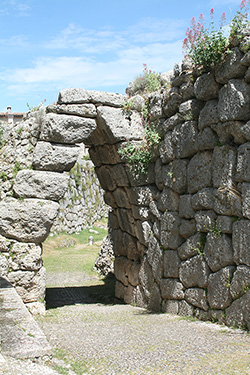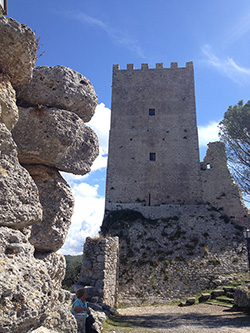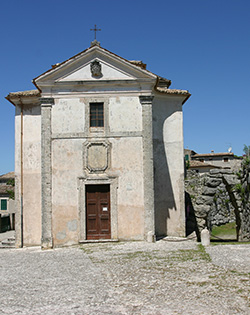| How to arrive here: From Arpino follow the road signs to Casalvieri. After 3 km, on the right there is the entrance to the Acropolis. It is advisable to leave the car in the parking outside the village’s entrance. |
 A small centre of human tradition gathered within a belt of megalithic walls the Civitas Vetus, the Acropolis still radiates fascination and a sense of archaic life to the turist who visits it. Civitavecchia was probably the original nucleus of a primitive Volscian settlement (7th-6th century) built as a defence on a place high and steep and then fortified by massive walls. The greatness of these walls, that can be seen in other towns of the Volscians (Atina, Aquinum, Sora, Signia, Arcis) and of the Ernicians (Aletrium), suggested popular imagination to call them pelasgian in memory of the mytical pre-Hellenic Pelasgians or Cyclopeans, Homer’s giants. Yet, they should be called polygonal because of the shape of the big stones which stand one upon the other without mortar.
A small centre of human tradition gathered within a belt of megalithic walls the Civitas Vetus, the Acropolis still radiates fascination and a sense of archaic life to the turist who visits it. Civitavecchia was probably the original nucleus of a primitive Volscian settlement (7th-6th century) built as a defence on a place high and steep and then fortified by massive walls. The greatness of these walls, that can be seen in other towns of the Volscians (Atina, Aquinum, Sora, Signia, Arcis) and of the Ernicians (Aletrium), suggested popular imagination to call them pelasgian in memory of the mytical pre-Hellenic Pelasgians or Cyclopeans, Homer’s giants. Yet, they should be called polygonal because of the shape of the big stones which stand one upon the other without mortar.
The polygonal walls of Arpino branch off from Civitavecchia at the altitude of 627 m a.s.l. and slope down until they embrace and encircle the town at the small rise of Civita Falconara. They have no foundations and are made of enormous monolith of pudding stone that can be found in the area surrounding the ancient site. The walls originally extended for 3 km but today only some 1,5 km are left and are at times enclosed within the houses. During the Samnite, Roman, and Medieval ages they were restaured and towers and gates were added. They have witnessed an uninterrupted series of historical events. The datation of the walls of Civitavecchia has prompted a debate among scholars: Schmidt dates them back to 7th-6th century BC, Sommella to the Roman era. Titus Livius (IV/57,7) tells of cyclopean Volscian rocks which existed already in 408 BC.
 The pointed arch, ancient gate to the Acropolis, revokes strongly the arches of Tyrins and Mycenae. This extraordinary monument is 4,20 m high and is made of overlapping stone blocks that became smaller towards the top and are cut slantwise on the external part. In the 16th century it was enclosed within a semicircular bastion which has been partially demolished.Recently ( 2005 ) it was founded another archaeological site, a gate to a fortified complex, situated at the foot of the hill , near the quarter Arco.
The pointed arch, ancient gate to the Acropolis, revokes strongly the arches of Tyrins and Mycenae. This extraordinary monument is 4,20 m high and is made of overlapping stone blocks that became smaller towards the top and are cut slantwise on the external part. In the 16th century it was enclosed within a semicircular bastion which has been partially demolished.Recently ( 2005 ) it was founded another archaeological site, a gate to a fortified complex, situated at the foot of the hill , near the quarter Arco.
Probably it was used as a secondary entrance to the Acropolis. It’s different from the famous pointed arch, it was named “Porta del Lupo” (the Gate of the Wolf) and it has well levelled polygonal blocks. It’s interesting the cave situated near the wall used for quarrying material for construction of the cyclopean walls.
There are neither architecture nor historical evidence of the Roman age in Civitavecchia but an old popular belief links it to the great Arpinate. It was indicated as Civitas Ciceroniana in the land register of the town in 1581 and the nearby Medieval tower is called “Cicero’s tower”. Evidence of the Medieval era are on the contrary real. Passing through the gate, built after the enclosure of the archaic one in a circular turret that hampered access to the village, you find on the left another tall square tower built to defend the castrum, encircled by Medieval walls, of which today only ruins are left. Inside it, a reservoir provided a source of water supply.
As Arpino became the Church’s bulwark in Southern Italy since 1215 the walls that sloped down from Civitavecchia towards Arpino were reinforced with squares and round towers, with bastions provided with blockhouses linked by rounds. A pleasant scenic walking which branches off from the centre of the village allows you to admire these historical buildings.
Near the ogive arch there is a 18th century jewel: the church of SS Trinità or of the Crucifix. It was built in 1720 by Cardinal Giuseppe Pesce, master and rector of the Pope’s Chapel and still is a property of the Pesce family. The church is in Romanesque style with a Greek plant. The dome stands over four central pillars; the altar’s frontal, painted with flowers, is the background of the small church. At its sides two big frescoes: on the left the Immaculate, on the right St Joseph . The Tyrolean Michele Stolz, a wooden sculptor, worked for Cardinal Pesce and was for long time guest in his house in Civitavecchia, where he died in 1779.
 He carved the statue of St. Vito, the image of the Crucifix, the small statue of the Conception, in addition to many other works for the churches of the town. Stolz’s style was undoubtedly rococo of Neapol tal influnce. Walking up the lane that cut across the village, paved with small typical cobbles, at number 6 you come at an ancient Palace which has a distinctive feature: at both sides of the main entrance two slides allowed the guardians of the dweller to keep under control unwanted guests or suspicious-looking people. Then you move to the church of St. Vito, a 16th century building with three naves.
He carved the statue of St. Vito, the image of the Crucifix, the small statue of the Conception, in addition to many other works for the churches of the town. Stolz’s style was undoubtedly rococo of Neapol tal influnce. Walking up the lane that cut across the village, paved with small typical cobbles, at number 6 you come at an ancient Palace which has a distinctive feature: at both sides of the main entrance two slides allowed the guardians of the dweller to keep under control unwanted guests or suspicious-looking people. Then you move to the church of St. Vito, a 16th century building with three naves.
On the main altar you can admire a painting by the Cavalier d’Arpino depicting St Vito, St. Crescenzo and St Modesto and the above mentioned statue of St Vito by Stolz. As you come out of the church, turning down the front street on the left, you come to a small round lookout that faces the valley down below. The ample horizon, the slopes of the rock covered with oak and olives trees that can be admired from here, the complete silence that reigns all over the place are truly enchanting.







